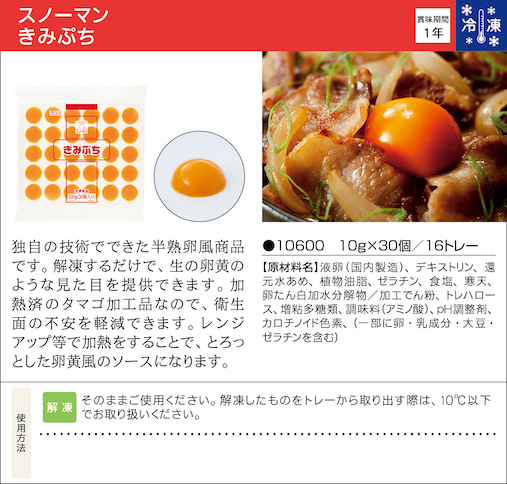Customer’s investigation leads to a discovery that’s shocked people around Japan.
Japanese convenience stores, or “konbini” as they’re colloquially known, have built up a reputation locally and abroad for their tasty food offerings, covering everything from seasonal desserts through to chicken nuggets, onigiri rice balls and bento lunch boxes.
The pre-made, heat-and-eat bentos are particularly popular with busy customers looking for something quick and substantial to eat, and while many believe they’re a healthier option compared to some of the fattier, oilier foods on sale, that theory is now being blown out of the water due to the discovery that they contain FAKE EGGS.
The shocking discovery has people reeling in Japan, and media outlets are now spreading the news after the revelation came to light with this tweet from Twitter user @coco_tsw., which reads:
“Those of you who fill your mouths with convenience store bentos without a second thought should look at this.
That egg you think you’re eating is not an egg. Eggs normally harden when heated, but the ones in konbini bentos melt when heated.
Why the heck would you want to put something like that in your mouth when you don’t know how it’s made?”
何も考えずにコンビニ弁当口に入れてるそこのアナタは今すぐこれを見るべき。
— ユッティ@脱ステ回復情報をお届け/アトピー脱ステロイド6年目!元気に回復 (@coco_tsw) January 8, 2020
アナタが卵だと思って食べてるそれは、卵じゃないよ。
普通卵は加熱したら固まるけど、
コンビニ弁当のは、加熱したら、溶けていってるよ😱
そんな一体何でできているのか訳の分からないものを口に入れたいですか? pic.twitter.com/pmYIRemj94
The tweet contains several images, including a photo of a 7-Eleven bento, which in this case contains a serving of pasta carbonara. While the word “bento” is conventionally used to describe a traditional Japanese boxed meal, it’s also colloquially used by people in Japan as a blanket term that covers Western-style pre-made meals in containers like this one as well.
Sitting in the middle of this bento is what looks like a raw egg, but as subsequent images show, when heated in a pan next to a real egg, the convenience store egg on the left turns into a bubbly, runny mess.
People were shocked at the discovery, leaving a range of comments like:
“Whaaaaat? I had no idea about this!”
“Omg I am shocked. This is frightening.”
“I’ve been eating them all this time and I thought they were real!”
“I’m going to read ingredient labels much more carefully now.”
“Actually, this makes sense as eggs can explode when heated up in the microwave.”
“I would be more scared if this was a real raw egg as that would be a salmonella risk.”
It’s true that a raw egg in a meal like this could cause customers to become ill, and that’s exactly why the fake egg is used, according to its creator, who is none other than Kewpie, the Japanese company behind the world-famous Kewpie mayonnaise.
▼ The “eggs”, which can be found on the official Kewpie site, are called “Snowman Kimipuchi” (“Snowman Petite Egg Yolks“)
Kewpie says their faux egg took over ten years to create, and was designed for commercial clients who wanted to add raw eggs to their products but were unable to due to health safety concerns. According to the description of the “Petite Egg Yolks” on the official site, these “eggs” turn into an “egg yolk-like sauce” when heated, which resembles the runny egg yolk favoured in dishes like oyakodon.
▼ According to this online sleuth, who caught wind of the pseudo eggs last year, the “egg” can be sliced neatly when cold as well.
ぷっくり卵黄型に固め、冷たい状態ではこのようにスプーンでスッときれる。熱を加えると溶け出してとろりとなるんですよ。これ考えた人天才だと思う。コンビニでやれることの制約の中で、最大の効果を生んでいる。みんなが大好きな卵黄とろりが、コンビニ飯で再現できてるんだよ。味は卵黄だし。 pic.twitter.com/Qt5H6gVM7j
— じろまるいずみ「餃子のおんがえし」(晶文社)発売中🥟 (@jiromal) March 15, 2019
Unlike a real egg, these manufactured yolks have a long list of ingredients which include locally manufactured “liquid eggs“, along with dextrin, glucose syrup, vegetable oil, gelatine, salt, agar, egg white protein, trehalose, polysaccharides, seasoning (amino acid), PH adjusting agents, and carotenoid colouring.
That’s a whole lot of additives and colourings you wouldn’t find in an ordinary egg, and it’s now prompting a lot of people in Japan to rethink their meal options when browsing the store shelves at their local konbini. Still, there are others who say they don’t care what the eggs are made from, as long as they taste good, which these reportedly do. And that’s not surprising, given they’re made by a mayonnaise manufacturer who celebrated their 100th anniversary with mayonnaise pudding.
Source: Jin
Featured image Twitter/@jiromal
Insert image: Kewpie
● Want to hear about SoraNews24’s latest articles as soon as they’re published? Follow us on Facebook and Twitter!


 Which Japanese convenience store has the best onsen tamago hot spring eggs?
Which Japanese convenience store has the best onsen tamago hot spring eggs? Raw eggs may lead to heads as bald as eggs
Raw eggs may lead to heads as bald as eggs What’s the most popular way to prepare Japan’s beloved breakfast dish, Tamago Kake Gohan?
What’s the most popular way to prepare Japan’s beloved breakfast dish, Tamago Kake Gohan? We try hone-jiru (bone soup), a delicious Okinawan specialty hard to find on mainland Japan
We try hone-jiru (bone soup), a delicious Okinawan specialty hard to find on mainland Japan Tasting Domino’s Japan’s new tsukimi moon-viewing pizza before its official release
Tasting Domino’s Japan’s new tsukimi moon-viewing pizza before its official release Hello Kitty, My Melody sukajan jackets combine symbols of Japan traditional, old-school, and cute
Hello Kitty, My Melody sukajan jackets combine symbols of Japan traditional, old-school, and cute 7-Eleven pancakes become a hit with American tourists in Japan
7-Eleven pancakes become a hit with American tourists in Japan Yokohama’s iconic Red Brick Warehouse is now transformed into a hotpot and sake tasting venue
Yokohama’s iconic Red Brick Warehouse is now transformed into a hotpot and sake tasting venue Studio Ghibli director Hayao Miyazaki shares his beloved car with fans
Studio Ghibli director Hayao Miyazaki shares his beloved car with fans Disney brings some cherry blossom magic to its spring merchandise in Japan
Disney brings some cherry blossom magic to its spring merchandise in Japan Osaka bans smoking on all of its streets, violators will be fined by patrols, vaping included
Osaka bans smoking on all of its streets, violators will be fined by patrols, vaping included 71-year-old Japanese man who “wanted to look cool” robbed 63 houses, treated strangers to sushi
71-year-old Japanese man who “wanted to look cool” robbed 63 houses, treated strangers to sushi Fashion for the young at heart! A different take on what it means to get older in Japan
Fashion for the young at heart! A different take on what it means to get older in Japan New instant noodles taste like that bland spaghetti they stick under hamburger in bentos
New instant noodles taste like that bland spaghetti they stick under hamburger in bentos How to cook miso soup (the right way) in a few simple steps【RocketKitchen】
How to cook miso soup (the right way) in a few simple steps【RocketKitchen】 Cherry blossoms blooming on new sakura Air Jordans from Nike【Photos】
Cherry blossoms blooming on new sakura Air Jordans from Nike【Photos】 Ghibli Park announces new ticket system, adds flexibility and low-priced options
Ghibli Park announces new ticket system, adds flexibility and low-priced options New Sanrio Little Twin Stars Kiki and Lala McDonald’s Happy Meal items are adorable and practical
New Sanrio Little Twin Stars Kiki and Lala McDonald’s Happy Meal items are adorable and practical Japanese Railway Lost Property Market: A treasure trove of lost items from trains
Japanese Railway Lost Property Market: A treasure trove of lost items from trains Put it on and look like Donkey Kong! Nintendo releases DK jackets, more for new merch line【Pics】
Put it on and look like Donkey Kong! Nintendo releases DK jackets, more for new merch line【Pics】 Shibuya’s other famous meeting spot statue has lost its home as part of redevelopment【Photos】
Shibuya’s other famous meeting spot statue has lost its home as part of redevelopment【Photos】 Pikachu is recharging as Pokémon and Uniqlo unveil adorable new Pokémon Sketch T-shirt line【Pics】
Pikachu is recharging as Pokémon and Uniqlo unveil adorable new Pokémon Sketch T-shirt line【Pics】 Our two-day struggle to buy the cutest onigiri rice balls in Tokyo
Our two-day struggle to buy the cutest onigiri rice balls in Tokyo Japan’s deadliest food claims more victims, but why do people keep eating it for New Year’s?
Japan’s deadliest food claims more victims, but why do people keep eating it for New Year’s? The top 10 annoying foreign tourist behaviors on trains, as chosen by Japanese people【Survey】
The top 10 annoying foreign tourist behaviors on trains, as chosen by Japanese people【Survey】 Anime Industry Report shows overseas anime market is bigger than Japanese one, but is this a cultural tipping point?
Anime Industry Report shows overseas anime market is bigger than Japanese one, but is this a cultural tipping point? Hayao Miyazaki says Happy New Year to Studio Ghibli fans with new art for Year of the Snake
Hayao Miyazaki says Happy New Year to Studio Ghibli fans with new art for Year of the Snake The My Melody ♡ Kuromi Anniversary Party is in full kawaii swing at the Ikebukuro Parco store
The My Melody ♡ Kuromi Anniversary Party is in full kawaii swing at the Ikebukuro Parco store McDonald’s Japan has a fukubukuro lucky bag that everyone wants to get their hands on
McDonald’s Japan has a fukubukuro lucky bag that everyone wants to get their hands on Sanrio pancakes celebrate My Melody’s birthday, and Cinnamoroll too, at Japanese cafes
Sanrio pancakes celebrate My Melody’s birthday, and Cinnamoroll too, at Japanese cafes What’s in Starbucks Japan’s fukubukuro lucky bag for 2025?
What’s in Starbucks Japan’s fukubukuro lucky bag for 2025? McDonald’s new Happy Meals offer up cute and practical Sanrio lifestyle goods
McDonald’s new Happy Meals offer up cute and practical Sanrio lifestyle goods Foreign tourists on Shinkansen bullet train break suitcase etiquette, angering local passengers
Foreign tourists on Shinkansen bullet train break suitcase etiquette, angering local passengers Possessing Harry Potter’s Sword of Godric Gryffindor is now illegal in Japan
Possessing Harry Potter’s Sword of Godric Gryffindor is now illegal in Japan [Deleted] Article written for April Fool’s Day 2018
[Deleted] Article written for April Fool’s Day 2018 Japanese government to make first change to romanization spelling rules since the 1950s
Japanese government to make first change to romanization spelling rules since the 1950s Foreigner’s request for help in Tokyo makes us sad for the state of society
Foreigner’s request for help in Tokyo makes us sad for the state of society Japanese convenience store Family Mart announces abolishment of eat-in spaces
Japanese convenience store Family Mart announces abolishment of eat-in spaces Life-size vibrating Legend of Zelda Master Sword for sale from Nintendo【Photos】
Life-size vibrating Legend of Zelda Master Sword for sale from Nintendo【Photos】 Studio Ghibli releases free-download board game — Here’s how to play it without reading Japanese
Studio Ghibli releases free-download board game — Here’s how to play it without reading Japanese Tsukimi Moon-Viewing season begins in Japan with new Yoshinoya gyudon beef bowls
Tsukimi Moon-Viewing season begins in Japan with new Yoshinoya gyudon beef bowls Bacon and Egg Sauce Katsudon: A new way to eat breakfast in Japan
Bacon and Egg Sauce Katsudon: A new way to eat breakfast in Japan If an onigiri and a cheeseburger had a baby, it’d be a Bakudan Musubi
If an onigiri and a cheeseburger had a baby, it’d be a Bakudan Musubi Ultimate TKG: We’ll never eat tamago kake gohan the old way again! 【Sora Kitchen】
Ultimate TKG: We’ll never eat tamago kake gohan the old way again! 【Sora Kitchen】 Smooth Mayonnaise Pudding served up in honor of Kewpie’s 100th anniversary
Smooth Mayonnaise Pudding served up in honor of Kewpie’s 100th anniversary Japanese media finds out if it’s cold enough to “fry” an egg on the street in Hokkaido
Japanese media finds out if it’s cold enough to “fry” an egg on the street in Hokkaido How to make the most beautiful at-home tamagokakegohan ever with a 100 yen store kitchen gadget
How to make the most beautiful at-home tamagokakegohan ever with a 100 yen store kitchen gadget KFC Japan unveils new Tsukimi Moon Viewing Burgers for 2024
KFC Japan unveils new Tsukimi Moon Viewing Burgers for 2024 Does this egg timer from Japanese 100-yen store Daiso really work?
Does this egg timer from Japanese 100-yen store Daiso really work? 25 different Japanese convenience store sandwiches – What’s inside them?【Photos】
25 different Japanese convenience store sandwiches – What’s inside them?【Photos】 Japan’s favorite pork cutlet sandwich maker also has awesome katsudon restaurant in Tokyo Station
Japan’s favorite pork cutlet sandwich maker also has awesome katsudon restaurant in Tokyo Station Japanese convenience store Lawson unveils a new type of egg sandwich
Japanese convenience store Lawson unveils a new type of egg sandwich FINALLY! An acceptable breakfast option at 7-Eleven! We try the Eggs Benedict Sandwich
FINALLY! An acceptable breakfast option at 7-Eleven! We try the Eggs Benedict Sandwich Japan has eggs that smell and taste like yuzu citrus fruit, and they’re amazing!
Japan has eggs that smell and taste like yuzu citrus fruit, and they’re amazing! Sukiya celebrates Tsukimi Moon-Viewing season with limited-edition gyudon beef bowls in Japan
Sukiya celebrates Tsukimi Moon-Viewing season with limited-edition gyudon beef bowls in Japan
Leave a Reply